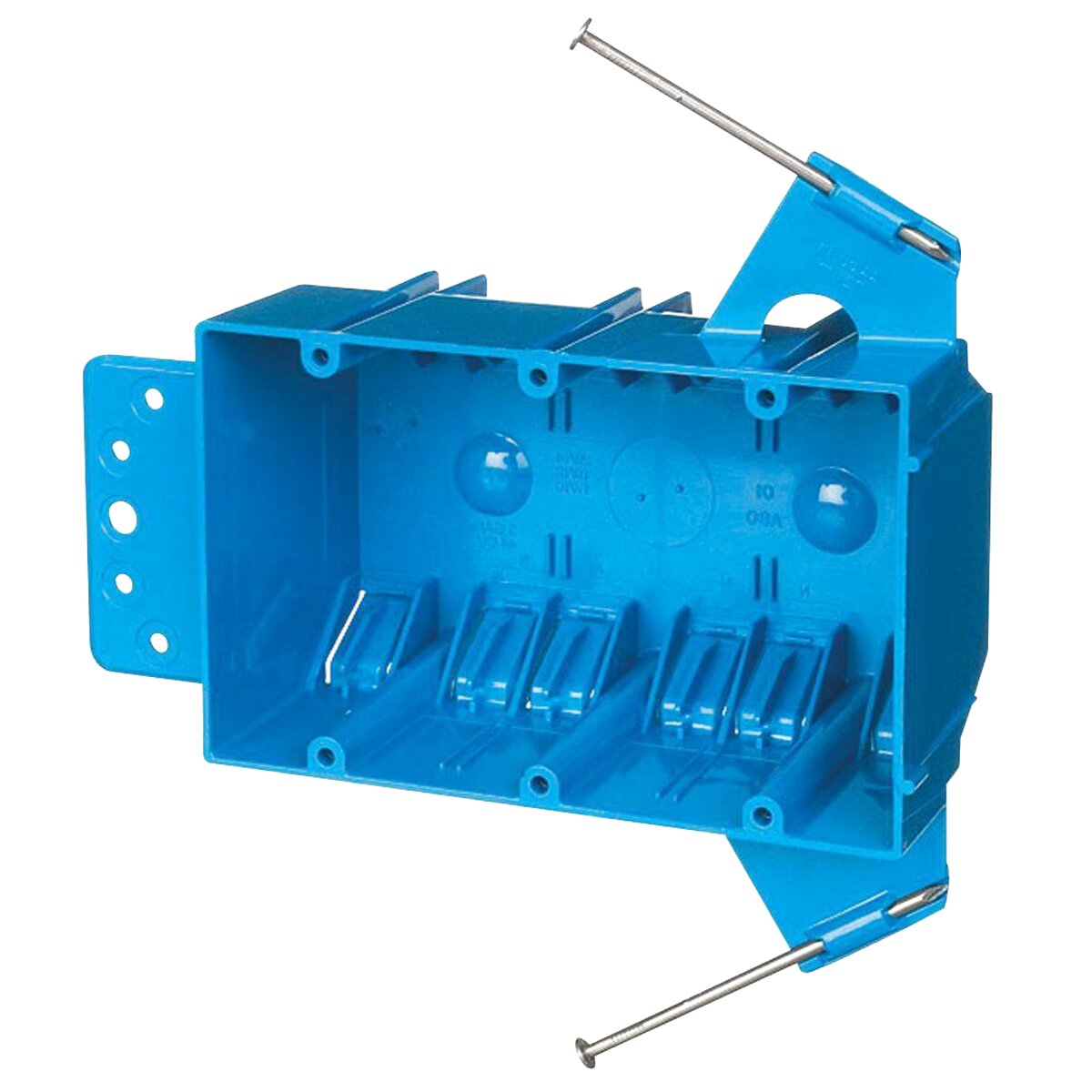This comprehensive guide covers everything you need to know about 3 gang boxes, from selecting the right type and size to understanding installation best practices. Whether you’re a seasoned electrician or a DIY enthusiast, this guide will equip you with the knowledge to tackle your next electrical project confidently.
Understanding 3 Gang Boxes
A 3 gang box is an electrical enclosure designed to house up to three separate electrical devices, such as switches, outlets, dimmers, or a combination. They provide a centralized, organized solution for managing multiple electrical functions in a single location, streamlining wiring and enhancing wall aesthetics. This section explores the key aspects of these versatile electrical components.
Types and Materials
Choosing the correct 3 gang box involves considering its material, installation type, and specific features.
Material:
- Metal (Steel/Aluminum): Known for their durability and excellent grounding capabilities, metal boxes are often preferred in commercial settings or areas requiring enhanced protection. They are likely more resistant to impact and high temperatures.
- Plastic (PVC/ABS): Lighter and generally less expensive, plastic boxes are well-suited for residential applications. They are also more resistant to corrosion. However, metal boxes might be a safer choice in areas susceptible to high heat or potential impact.
Installation Type:
- New Construction (New Work Boxes): Designed for installation before drywall, offering flexibility in placement.
- Old Work (Retrofit Boxes): Ideal for existing walls, featuring wings or clamps that grip the drywall, eliminating the need for access behind the wall.
- Masonry Boxes: Specifically designed for brick or concrete walls, these boxes are anchored directly into the masonry.
- Low-Voltage Boxes: Used exclusively for low-voltage applications (e.g., phone lines, internet cables, speaker wires). Important: Never use these for standard electrical wiring.
Size and Capacity
3 gang boxes are measured in cubic inches (cu. in.), indicating their capacity for wiring and devices. Avoid overcrowding, as it poses a fire hazard. Common sizes include 44, 49, 53, and 55 cu. in. Larger boxes offer more space for wiring and accommodate thicker gauge wires. The depth of the box is equally important, providing ample room for multiple cables or thicker wires.
Key Features
Certain features can simplify installation and improve safety:
- Adjustable Depth: Compensates for uneven walls, ensuring the box sits flush with the surface.
- Concentric Knockouts (KOs): Pre-drilled holes for easy conduit installation, accommodating various conduit diameters.
Planning and Installation
Proper planning and adherence to safety protocols are essential for a successful installation.
Pre-Installation Checklist
- Planning: Determine the desired location, appropriate box type and capacity, and map your wiring plan.
- Power Down: Crucially, turn off the power at the breaker box before starting any electrical work.
- Local Codes: Always consult local electrical codes, as regulations vary. This guide provides a general overview.
Installation Steps
- New Work: Secure the box to a stud or use mounting brackets.
- Old Work: Cut the appropriate opening in the drywall, insert the box, and secure it with clamps or wings.
- Wiring: Connect wires according to your wiring diagram and local codes. Ensure proper grounding.
- Device Mounting: Securely mount your switches or outlets to the box.
- Testing: After completing the wiring, turn the power back on and test all devices.
Where to Buy
- Big Box Stores (Home Depot, Lowe’s): Offer a good selection of standard boxes.
- Online Marketplaces (Amazon, eBay): Provide a wider variety and potential cost savings.
- Electrical Supply Stores: Offer specialized boxes, expert advice, and assistance in choosing the right box.
What is a 3 Gang Box? (In-Depth)
A 3 gang box, often referred to as a triple gang box, consolidates three electrical devices within a single unit. This integrated approach offers several advantages over using individual boxes: streamlined aesthetics, simplified wiring, and efficient use of wall space. The “3 gang” designation indicates its capacity for three devices – switches, outlets, dimmers, or a combination thereof.
Dimensions and Materials
Standard dimensions are approximately 4.63″ high x 6.5″ wide. However, variations exist depending on the manufacturer. Always double-check specifications before purchasing to ensure compatibility with your chosen devices. Materials include:
- Metal (Steel/Aluminum): Durable and provide excellent grounding.
- Plastic (ABS): Lightweight, easier to work with, and non-conductive. Some experts suggest that plastic offers greater safety in certain environments, but ongoing research continues to evaluate the performance of various materials.
Planning and Safety
Before installation:
- Device Selection: Determine the specific devices you plan to install, as this influences box type and wiring requirements.
- Capacity Check: Ensure the box has sufficient internal capacity to accommodate all wires and connectors without overcrowding.
- Code Compliance: Adhering to local electrical codes is paramount for safety and compliance. Consult a qualified electrician if needed.
What is the difference between 1 gang, 2 gang, and 3 gang?
“Gang” in electrical boxes refers to the number of devices the box can accommodate.
- 1 Gang: Houses a single device (e.g., one switch or outlet).
- 2 Gang: Accommodates two devices (e.g., two switches, or a switch and an outlet).
- 3 Gang: Holds three devices (e.g., three switches, or a combination of switches and outlets).
Selecting the correct gang size is crucial for safety and code compliance. Overcrowding a box poses a fire hazard and may lead to malfunctions. Future research may involve exploring standardized configurations as smart home technology advances and wiring complexity increases.
| Gang Size | Number of Devices | Example |
|---|---|---|
| 1-Gang | 1 | Single light switch, single outlet |
| 2-Gang | 2 | Two light switches, light switch & dimmer |
| 3-Gang | 3 | Three light switches, or a combination |
What is a 3 Gang Outlet?
A 3 gang outlet, more accurately a 3 gang outlet box, provides space for three devices within a single unit. This is particularly advantageous in areas requiring multiple electrical access points, like kitchens or entertainment centers.
Material and Dimensions
Traditional metal boxes (steel, pre-galvanized) offer durability, while modern non-metallic (ABS plastic) boxes provide lighter weight, easier installation, and non-conductivity. Standard 3-gang box dimensions are approximately 6.5″ wide and 4.63″ high, but depth can vary. Always measure your space and verify box dimensions before purchase.
Devices and Installation
3 gang boxes can accommodate a variety of devices, from standard switches and receptacles to specialized components like dimmers, timers, USB charging ports, and motion sensors. Installation can be surface-mounted or recessed. While DIY installation is possible, consulting a qualified electrician is recommended for complex wiring or if you are unsure about any aspect of the installation, especially given ongoing research into simplifying these installations for DIYers.
Gang Box Comparison
| Gang Box | Number of Devices |
|---|---|
| 1-Gang | 1 |
| 2-Gang | 2 |
| 3-Gang | 3 |
Dive headfirst into the detailed 2×6 Span Chart to master the nuances of construction charting.
- Doubling 1/3 Cup: Quick Answer and Easy Kitchen Conversions - March 22, 2025
- J Middleton Unit (Abilene, TX): Inmate Search, Visitation, and Contact Information - March 22, 2025
- Ivermectin Dosage for Dogs: A Weight-Based Guide - March 22, 2025










